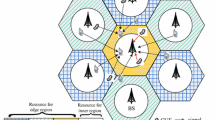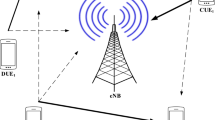Abstract
Device-to-Device (D2D) multicast will become an important technology with the increasing requirements of local communication services in future networks. To increase the overall capacity and improve resource utilization, a novel interference coordination scheme is proposed. The proposed scheme includes three steps. First, in order to mitigate the interference from D2D multicast transmission to cellular networks (CNs), a dynamic power control scheme is proposed that can determine the upper bound of D2D transmitter power based on the location of Base Station and areas of adjacent cells from the coverage area of D2D multicast group. Next, an interference limited area control scheme that reduces the interference from CNs to each D2D multicast receiver is proposed. The proposed scheme does not allow the coexistence of cellular equipments (CUEs) located in the interference limited area to reuse the same resources as the D2D multicast group. Then two resource block (RB) allocation rules are proposed to select the appropriate RBs from a candidate RB set for D2D multicast group. From the simulation results, it is confirmed that the proposed schemes improve the performance of the hybrid system compared to the conventional ways.






Similar content being viewed by others
References
Doppler, K., & Xiao, M., Eds. (2008). Innovative concepts in Peer-to-Peer and network coding. WINNER\(+\)/CELTIC Deliverable CELTIC/CP5-026 D1.3.
Jänis, P., & Yu, C.-H. (Jun. 2009). Device-to-device communication underlaying cellular communications systems. Proceedings of IEEE IJCNS, 2(3), 169–178.
Doppler, K., Yu, C.-H., Ribeiro, C. B., & Jänis, P. (2010). Mode selection for device-to-device communication underlaying an LTE-Advanced network. In Proceedings of IEEE WCNC 2010, pp. 1–6, April 2010.
Ji, J., & Chen, W. (2012). Capacity analysis of multicast transmission schemes in a spectrum-sharing scenario. IET Communications, 6(17), 2974–2979.
Deng, H., Tao, X. M., Ge, N., & Lu, J. H. (2012). Joint mode selection and resource allocation for cellular controlled short-range communication in OFDMA networks. IEICE Transactions on Communications, E95–B(3), 1023–1026.
Min, H., Lee, J., Park, S., & Hong, D. (Dec. 2011). Capacity enhancement using an interference limited area for device-to-device uplink underlaying cellular networks. IEEE Transactions on Wireless Communications, 10(1), 3995–4000.
Yu, C.-H., Tirkkonen, O., Doppler, K., & Ribeiro, C. B. (2009). Power optimization of device-to-device communication underlaying cellular communication. In Proceedings of IEEE ICC 2009, pp. 1–5, April 2009.
Hsieh, H.-Y., & Sivakumar, R. (2004). On using peer-to-peer communication in cellular wireless data networks. IEEE Transactions on Mobile Computing, 3(1), 57–71.
Du, Y., Sun, L., & Ma, N. (2004). Method and system for peer-to-peer communication management in wireless communication networks, US Patent Nos. 7 308 266.
Doppler, K., Rinne, M. P., Wijting, C., Ribeiro, C. B., & Hugl, K. (2009). Device-to-device communication as an underlay to LTE-advanced networks. IEEE, Communications Magazine, 47(12), 29–42.
Holma, H., & Tosjala, A. (2009). LTE for UMTS: OFDMA and SC-FDMA based radio access. New York: Wiley.
Makr, J. W., & Zhuang, W. (2003). Wireless communications and networking. Upper Saddle River: Prentice Hall.
Bellman, R. (1956). Dynamic programming and Lagrange multipliers. In Proc Natl Acad Sci USA. Vol. 42, No. 10, pp. 767–769, October 1956
Suh, C., & Mo, J. (2008). Resource allocation for multicast services in multicarrier wireless communications. IEEE Transactions on Wireless Communications, 7(1), 27–31.
Zhang, H., Wang, X., Li, F., & Dai, H. (2012). Channel-aware adaptive resource allocation for multicast and unicast services in orthogonal frequency division multiplexing systems. IET Communications, 6(17), 3006–3014.
Peng, T., Lu, Q., Wang, H., Xu, S., & Wang, W. (2010). Interference avoidance mechanisms in the hybrid cellular and device-to-device systems. Proceedings of IEEE PIMRC, 2009, 617–621.
ETSI 30.03. (1998). Selection procedures for the choice of radio transmission technologies for UMTS, TR 101 112, v3.2.0.
3GPP TSG-RAN. (2011). E-UTRA radio frequency system scenarios, 3GPP technical report, 3G. TR 36.942, v9.2.0.
Acknowledgments
This work was supported by important national science and technology specific projects (2012ZX03003011), and the national natures science foundation of China (6097206, 61072052).
Author information
Authors and Affiliations
Corresponding author
Rights and permissions
About this article
Cite this article
Wang, D., Wang, X. Effective Interference Cancellation Schemes for Device-to-Device Multicast Uplink Period Underlaying Cellular Networks. Wireless Pers Commun 75, 2201–2216 (2014). https://doi.org/10.1007/s11277-013-1463-7
Published:
Issue Date:
DOI: https://doi.org/10.1007/s11277-013-1463-7




